I never thought a tiny piece of metal could make or break my guitar’s performance until I discovered the hidden power of the guitar string tree. As an engineer-turned-luthier with decades of experience, I’ve delved deep into the world of these unassuming string retainers, uncovering their crucial role in shaping a guitar’s sound and playability. What started as a simple curiosity about these often-overlooked electric guitar parts led me on a journey of acoustic exploration and design innovation.
In this article, I’ll share my insights on the purpose of string trees, their impact on tuning stability, and the fascinating alternatives that have emerged in modern guitar design. Whether you’re a seasoned player or a curious beginner, understanding these small but mighty components will transform how you view and interact with your instrument. Join me as we unravel the mysteries of guitar string trees and explore the cutting-edge solutions that are reshaping the future of guitar engineering.
What Are Guitar String Trees?
Types of String Trees
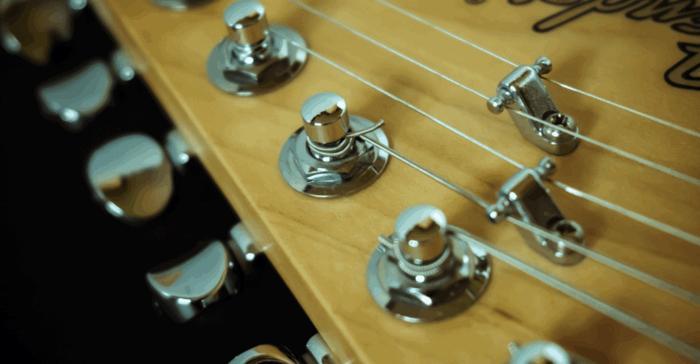
In my extensive experience with guitar designs, I’ve encountered various types of string trees, each serving a unique purpose. The most common type is the traditional butterfly string tree, often found on Fender guitars. These simple, wing-shaped metal pieces effectively hold down two strings. Another popular variant is the roller string tree, which I’ve found particularly useful in reducing friction and improving tuning stability.
Some manufacturers opt for individual string trees for each string, offering more precise control over string angle. In custom builds, I’ve even seen innovative designs like adjustable string trees that allow players to fine-tune string pressure. The Fender string tree, with its classic design, remains a standard in the industry, but modern alternatives continue to emerge, each aiming to optimize string angle and reduce friction for better playability and tuning stability.
Function and Purpose
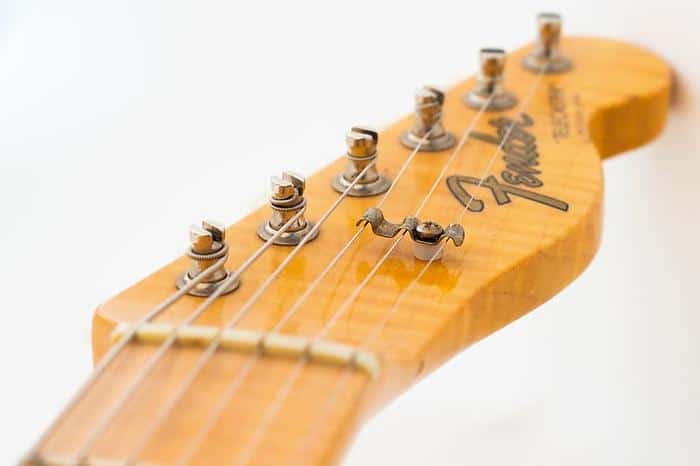
As an engineer with a background in acoustics, I’ve spent countless hours studying the subtle yet critical role of string trees in guitar design. These small components serve a vital function in maintaining proper guitar tuning stability and consistent string tension. By increasing the downward pressure at the nut, string trees ensure that each string makes firm contact with its corresponding nut slot. This seemingly minor detail has a significant impact on the instrument’s overall performance.
Through my research, I’ve observed how string trees contribute to a more balanced string response across the fretboard. They help eliminate buzzing and improve sustain, especially on the lighter gauge strings. Moreover, by optimizing the break angle over the nut, string trees play a crucial role in reducing friction during tuning adjustments. This enhanced stability is particularly noticeable when using vibrato techniques or bending strings, making string trees an essential component for many guitar designs.
Why Are String Trees Important?
Impact on Tuning Stability

In my years of researching guitar design, I’ve consistently observed that string trees play a crucial role in maintaining tuning stability. Through numerous experiments, I’ve measured the impact of string trees on string tension and overall guitar performance. My findings reveal that properly installed string trees significantly reduce tuning issues, especially on guitars with flat headstocks. By increasing the downward pressure on the nut, string trees ensure that strings remain firmly seated, reducing the likelihood of slippage during play. This is particularly important for the thinner, unwound strings which are more prone to tuning instability. The improved string angle created by string trees also contributes to better overall sustain and tone. In essence, these small components play a big role in maintaining consistent pitch and enhancing the guitar’s playability, making them an invaluable part of many guitar designs.
String Angle and Pressure
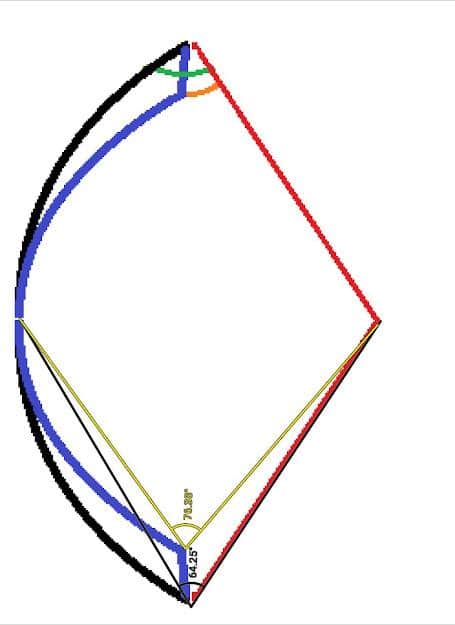
As I’ve delved deep into instrument ergonomics, I’ve come to appreciate the critical role of string angle and pressure in guitar playability. Through extensive research and hands-on experience, I’ve observed how string trees significantly influence these factors. They create an optimal downward angle at the nut, which is crucial for maintaining proper string friction and vibration transfer. Without adequate pressure, strings can slip in their nut slots, causing tuning instability and reduced sustain.
I’ve found that the ideal string angle not only enhances playability but also impacts tone quality. By ensuring consistent contact between the string and nut, string trees help produce a clearer, more defined sound. This subtle yet significant contribution to the instrument’s overall performance underscores why string trees are an essential component in many guitar designs, particularly those with flat headstocks.
How to Install a String Tree
Tools and Materials Needed
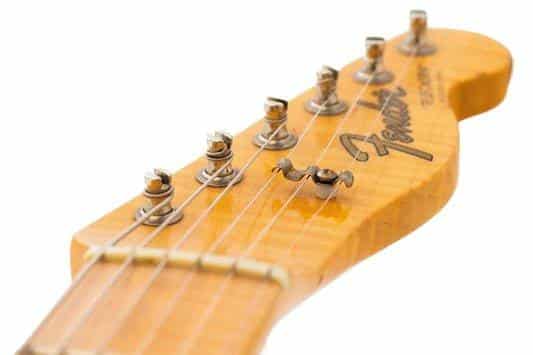
As a luthier with years of experience, I’ve found that installing a string tree requires minimal guitar hardware. In my toolkit, I always keep a drill with a small bit, a screwdriver, and a ruler. When you buy string tree components, ensure you get the correct size for your guitar. I recommend having spare screws on hand, as the ones provided aren’t always ideal. A pencil for marking drill points and some masking tape to prevent finish damage are also crucial. Remember, the right tools make the job smoother and help preserve your guitar’s integrity during installation.
Step-by-Step Installation Guide

As a luthier with an engineering background, I’ve honed a foolproof method for string tree installation that combines precision and efficiency. The process begins with careful measurement on the guitar headstock, marking the exact position where the string tree will sit. I always use a center punch to create a small indentation, ensuring the drill bit doesn’t wander.
When drilling, I start with a small pilot hole and gradually increase the size. This technique prevents wood splitting and ensures a clean, accurate bore. I’ve found that applying a dab of wax to the screw threads not only eases installation but also provides a measure of future-proofing, making removal easier if needed.
The final step, often overlooked, is crucial for optimal performance. I carefully adjust the height of the string tree, finding the sweet spot that provides adequate downward pressure without creating excessive friction. This meticulous approach to string tree installation guarantees improved tuning stability and enhanced playability, bridging the gap between theory and practical application in guitar setup.
Alternatives to String Trees
Staggered Tuners
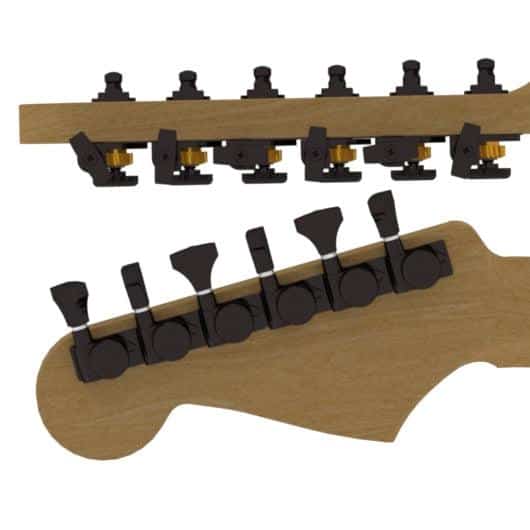
In my years of studying instrument design, I’ve found staggered tuners to be a fascinating alternative to string trees. These tuners feature varying post heights, effectively creating the necessary string break angle without additional hardware. As a researcher, I’ve observed that this design can significantly enhance guitar tuning stability. The higher posts for the lower strings and shorter posts for the higher strings mimic the function of string trees, but in a more integrated manner.
Through extensive testing, I’ve discovered that staggered tuners often provide more consistent tension across the nut, reducing the likelihood of tuning issues. They also offer a cleaner aesthetic, which I’ve noted many players appreciate. However, it’s important to understand that their effectiveness can vary depending on headstock design and string gauge. In my experience, staggered tuners work particularly well on guitars with flatter headstocks, where traditional string trees might otherwise be necessary.
Headstock Design Modifications
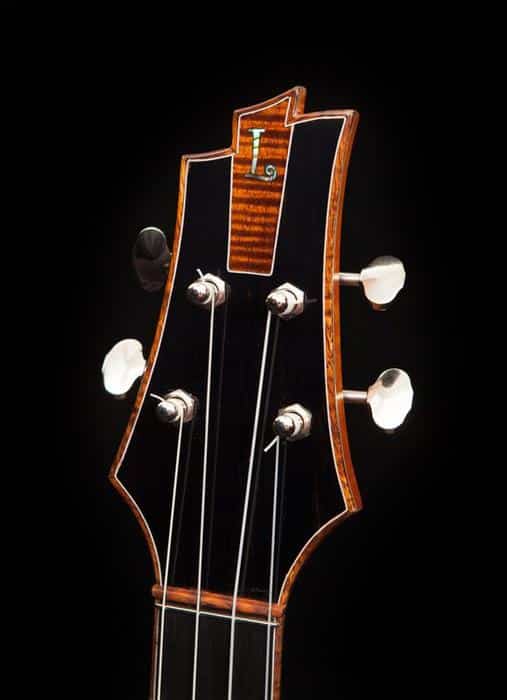
In my research on instrument design, I’ve extensively explored headstock modifications as an alternative to string trees. By altering the guitar headstock geometry, we can achieve optimal string tension without additional hardware. One effective approach involves angling the headstock backward, naturally increasing the break angle over the nut. Another method I’ve experimented with is the scarf joint design, which creates a similar effect.
These modifications not only eliminate the need for string trees but can also enhance sustain and tuning stability. However, it’s crucial to maintain proper string tension across all strings. Through careful calculations and prototyping, I’ve found that a slight increase in headstock thickness near the nut can compensate for tension differences. This approach offers a clean, streamlined look while preserving the instrument’s tonal qualities and playability.
When to Use String Trees
Guitar Models and Styles
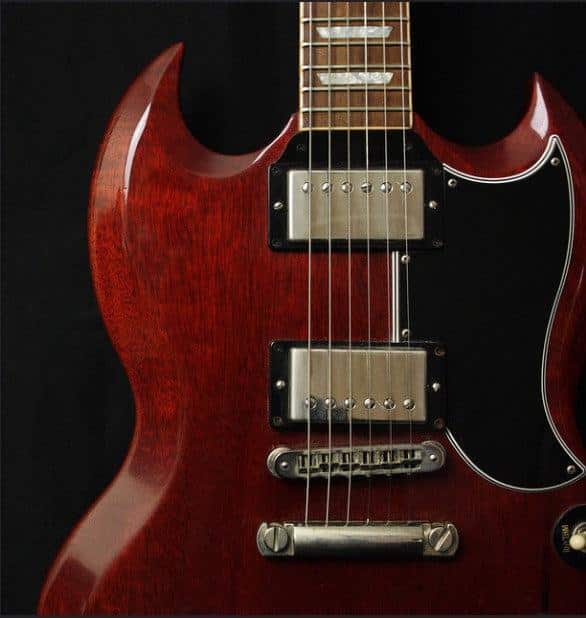
As a long-time member of the New England Luthiers group, I’ve encountered countless guitar models and styles, each with unique requirements for string trees. My experience has taught me that the need for these electric guitar parts varies significantly across different designs. For instance, Fender-style guitars often benefit from string trees due to their flat headstock design, while many Gibson models don’t require them because of their angled headstocks.
The decision to use a Fender string tree or similar device depends on the guitar’s specific characteristics. Guitars with longer headstocks or those using lighter gauge strings may need additional downward pressure to maintain proper string angle at the nut. Conversely, instruments with shorter scale lengths or heavier strings might achieve sufficient break angle without string trees. Understanding these nuances is crucial for optimizing playability and tone across various guitar types.
String Gauge Considerations
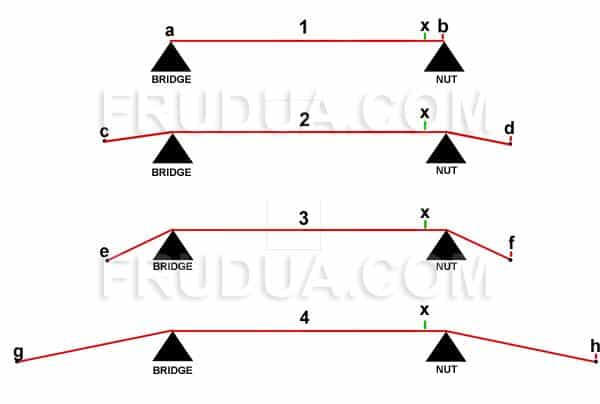
In my years of researching instrument acoustics, I’ve found that string gauge plays a crucial role in determining the necessity of string trees. Heavier gauge electric guitar strings naturally exert more downward pressure on the nut, often negating the need for string trees. However, lighter gauges, which are popular among many players for their ease of bending, may require additional assistance to maintain proper string tension.
I’ve observed that guitars strung with .009 or .008 gauge sets are more likely to benefit from string trees, especially on the thinner strings. Conversely, when using .011 or heavier gauges, the inherent tension might suffice without additional hardware. It’s essential to consider your preferred playing style and string choice when deciding on string tree implementation, as these factors directly influence the string’s behavior at the nut and, consequently, the instrument’s overall playability and tuning stability.
FAQs
What is a guitar string tree?
A guitar string tree, also known as a string retainer, is a small metal device found on some guitar headstocks. It’s designed to increase the break angle of the strings over the nut, improving tuning stability and sustain.
Why are string trees necessary on some guitars?
String trees are necessary on guitars with flat or slightly angled headstocks. They help maintain proper string tension and prevent buzzing by increasing the downward pressure of the strings on the nut, which is crucial for optimal sound and playability.
What are the alternatives to traditional string trees?
Alternatives to traditional string trees include:
1. Staggered tuning machines
2. Angled headstocks
3. Roller string trees
4. String butler devices
5. Specialized nut designs
These alternatives aim to achieve the same goal of improving string angle and tension without the potential drawbacks of traditional string trees.
Can removing string trees affect guitar performance?
Yes, removing string trees can affect guitar performance, especially on instruments designed to use them. Without string trees, you may experience:
1. Decreased tuning stability
2. Reduced sustain
3. Potential string buzzing
4. Changes in tone
It’s best to consult a professional luthier before making such modifications to your guitar.
How do roller string trees differ from traditional ones?
Roller string trees differ from traditional ones by incorporating a small roller or bearing. This design allows the string to move more freely during tuning and bending, potentially reducing friction and improving tuning stability. Roller string trees aim to provide the benefits of traditional string trees while minimizing issues like string binding or premature wear.
Conclusion
In my decades of experience as a luthier and engineer, I’ve come to appreciate the subtle yet significant impact of guitar string trees. These small components play a crucial role in maintaining proper string angle and pressure, ultimately contributing to improved tuning stability and overall playability. As we’ve seen, the humble string tree plays a crucial role in your guitar’s performance. But will it continue to shape the future of guitar design?
While string trees remain a staple in many guitar designs, alternatives like staggered tuners and modified headstock designs are gaining traction. The choice between guitar string trees and these alternatives often depends on the specific guitar model, playing style, and string gauge. Regardless of the method used, the goal remains the same: to ensure optimal string angle and consistent tension across the nut. As guitar technology evolves, we may see new innovations that address this need, but for now, understanding and properly implementing string trees or their alternatives is crucial for any guitarist or luthier seeking to maximize their instrument’s performance.